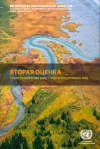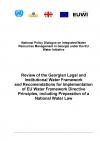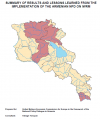Publications
Displaying Results 301 - 320 of 673
- English
The Second Assessment provides a comprehensive overview of the status of transboundary waters in the European and Asian parts of the UNECE region, covering more than 140 transboundary rivers, 25 transboundary lakes, about 200 transboundary groundwaters and 25 Ramsar Sites or other wetlands of transboundary importance.
It has been carried out under the auspices of the Meeting of the
- Pусский
Национальный политический диалог по Интегрированному Управлению Водными Ресурсами в Грузии в рамках Европейской Водной Инициативы. Проблемы по управлению трансграничными водными ресурсами в Грузии, трансграничное водное сотрудничество с соседним Азербайджаном и подготовка к присоединению Грузии к Водной конвенции ЕЭК ООН.
- English
National Political Dialogue on Integrated Management of Water Resources in Georgia in the Framework of European Water Initiative. Transboundary Water resources Management Problems in Georgia, Transboundary Water Cooperation with Neighboring Azerbaijan and Getting Prepared for accession of Georgia to the Convention on the Protection and Use of Transboundary Watercourses and International Lakes (
- English
Review of the Georgian Legal and Institutional Water Framework and Recomendations for Implementation of EU Water Framework Directive Principles, including Preparation of a National Water Law. National Policy Dialogue on Integrated Water Resources Management in Georgia under the EU Water Initiative.
Prepared by: Malkhaz Dzneladze, Legal expert
malkhaz.dzneladze@gmail.
- English
National Policy Dialogue on Integrated Water Resources Management in Georgia under the EU Water Initiative.The National Policy Dialogue on Integrated Water Resources Management (NPD/IWRM) led by the Ministry of Environmental Protection of Georgia in cooperation with the UNECE and with the support of the Georgian National Water Partnership started in September 2010 with meetings of
- English
Part I of the publication describes the target settting process in the Republic of Moldova.Part II of the publication presents the current situation and issues to be dealt with under the Protocol on Water and Health together with targets, target dates and proposed measures.@ UNECE - United Nations Economic Commission for Europe, and SDC - Swiss Agency for Development and CooperationDownload
- Pусский
Brochures about the Protocol on Water and Health Женева, 2010Download this Publicaton
- English
Brochures about the Protocol on Water and Health Geneva, 2010Download this Brochure in English and Russian
Small Scale Water Supplies in the pan-European Region: Background — Challenges — Improvements (2010)
- English
Improvements Background • Challenges • Improvements © World Health Organization 2010, UNECE 2010Download this Publication
- English
OECD – UNECE INTERIM REPORT 2010
The European Union’s Water Initiative (EUWI) is a political initiative which seeks to assist partner countries in achieving water-related Millennium Development. The EUWI EECCA is the regional component of the EUWI focused on Eastern Europe, the Caucasus and Central Asia (EECCA). It supports work of the European Neighbourhood Policy and of the EU-Central
- Pусский
- English
- English
- Pусский
Протокол по проблемам воды и здоровья, совместно обслуживаемый ЕЭК ООН/ВОЗ-Евро, был принят в особенности для того, чтобы гарантировать снабжение безопасной питьевой водой и достаточными санитарно-гигиеническим условиями для каждого, посредством построения связи между управлением водными ресурсами и проблемами здоровья. Его основной целью является охрана здоровья и благополучия человека путем
- Français
The UNECE/WHO-Europe Protocol on Water and Health has been negotiated specifically to ensure, by linking water management and health issues, the supply of safe drinking water and adequate sanitation for everyone. Its main aim is to protect human health and well-being through preventing, controlling and reducing water-related diseases and through improving water management. Setting targets and













